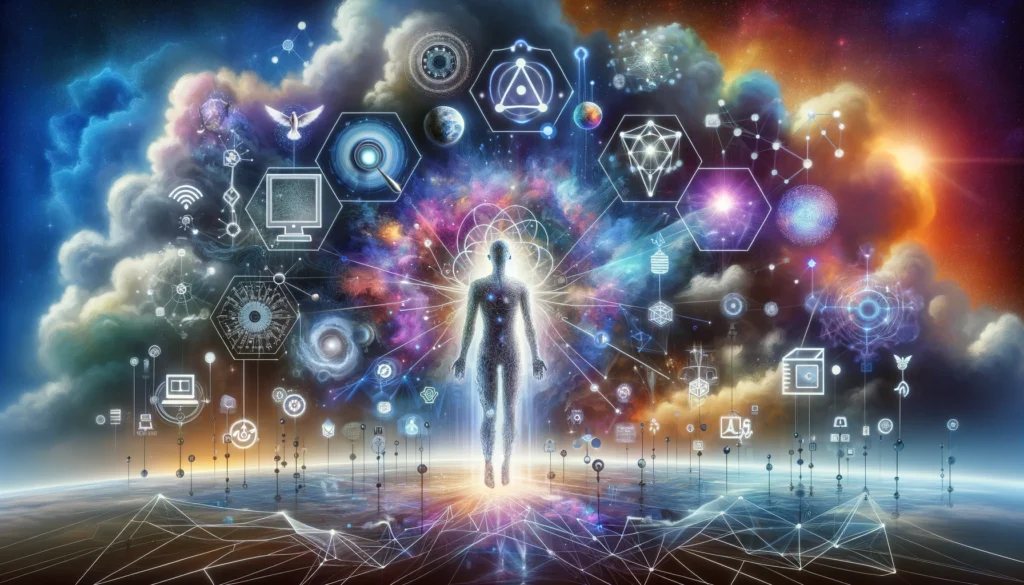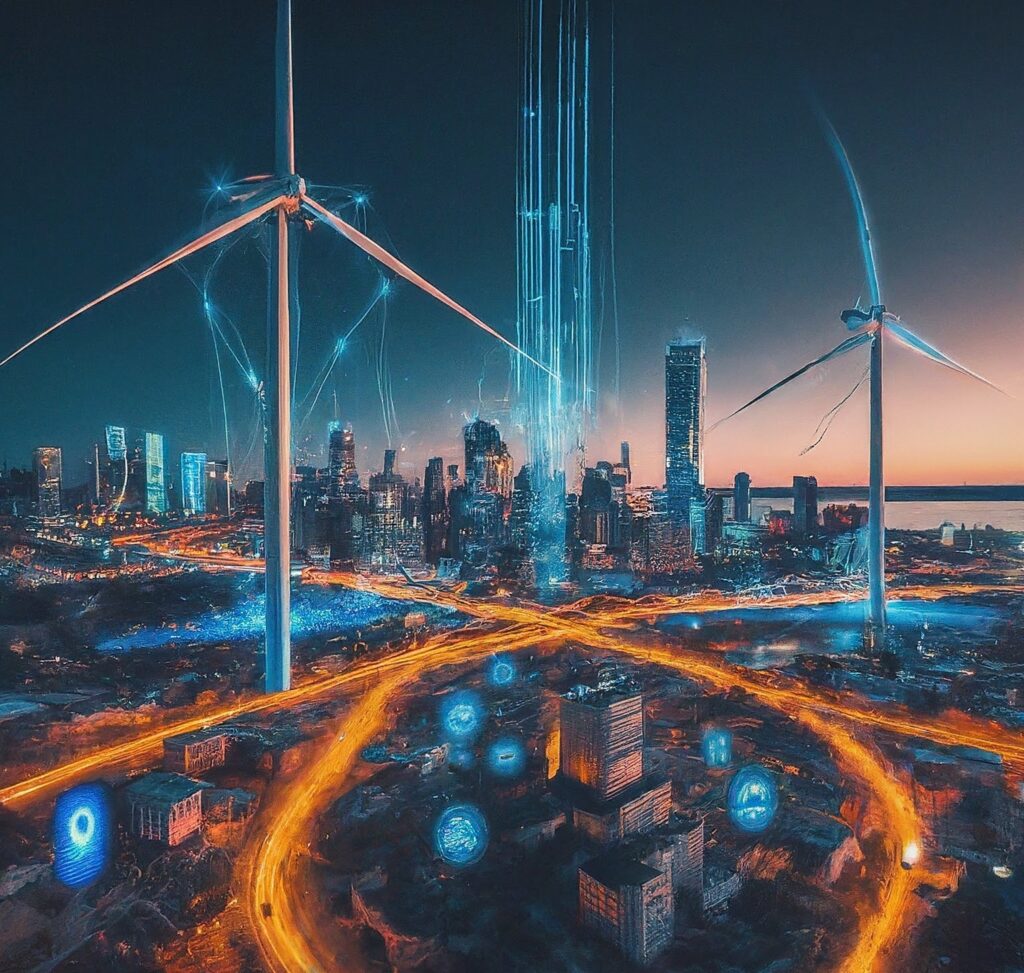Table of Contents
Navigating the Metaverse: A Glimpse into the Future of Digital Worlds
Check it out on YouTube

The Metaverse is heralded as the next frontier in digital evolution, offering a glimpse into a future where virtual and physical realities merge to create new realms of possibility.
At its core, the Metaverse is a collective virtual shared space, accessible through the internet and enriched by the convergence of virtual augmented reality (VR), augmented reality (AR), and the internet. This concept is not just about enhancing our digital interactions but redefining the boundaries of reality itself.
The Essence of the Metaverse
The Metaverse represents an expansive network of 3D virtual worlds focused on social connection. In this digital universe, users can interact, work, play, and learn in environments that defy the physical limitations of the real world.
The promise of the Metaverse lies in its potential to offer immersive experiences that are as rich and complex as those in the physical world, but with the added benefits of digital technology’s scalability, creativity, and accessibility.
The Impact of the Metaverse
The implications of the Metaverse extend far beyond entertainment and gaming. It has the potential to revolutionize industries by offering new platforms for education, virtual tourism, remote work, and social networking.
In the Metaverse, we can attend concerts, visit art galleries, or explore virtual worlds from the comfort of our homes, providing a new dimension to digital engagement and opening up a world of opportunities for creators, educators, and businesses alike.
The Technology Behind the Metaverse
Realizing the vision of the Metaverse requires advanced technologies like VR and AR for immersive experiences, blockchain for secure and decentralized transactions, and AI to create dynamic, interactive environments.
Together, these technologies ensure that the Metaverse is not only visually engaging but also a secure, efficient, and scalable space where users can have meaningful interactions and transactions.
The Future of the Metaverse
As we venture further into the development of the Metaverse, questions about governance, privacy, and accessibility remain. Ensuring an open, inclusive, and safe digital universe will be crucial for its long-term success and adoption. Despite these challenges, the Metaverse stands as a testament to human ingenuity and the endless possibilities of digital innovation.
Conclusion
The Metaverse is more than just a digital space; it’s a vision for the future of connectivity, creativity, and community. As technology continues to evolve, the Metaverse will likely become an integral part of our lives, blurring the lines between the virtual and the real and opening up new avenues for exploration, interaction, and growth. The journey into the Metaverse is just beginning, and its potential to reshape our digital landscape is immense.
Unveiling Artificial Intelligence: Revolutionizing the Digital and Real World.
Check it out on YouTube

Artificial Intelligence (AI) stands at the forefront of technological advancement, reshaping industries, enhancing human capabilities, and transforming the way we interact with the world. This blog post delves into the essence of AI, its significant impacts, and the future it heralds for humanity.
The Essence of Artificial Intelligence
AI is a broad field of computer science focused on creating intelligent machines capable of performing tasks that typically require human intelligence. This includes learning from experiences, recognizing patterns, understanding complex data, making decisions, and solving problems. AI encompasses various technologies, including machine learning (ML), natural language processing (NLP), robotics, and computer vision, each contributing to its diverse applications.
Transforming Industries and Daily Life
AI’s impact is profound and far-reaching. In healthcare, AI algorithms can diagnose diseases with high accuracy, personalize treatment plans, and predict outbreaks. In finance, AI enhances fraud detection, automates trading, and offers personalized banking services.
The technology is also revolutionizing transportation through autonomous vehicles, improving efficiency in manufacturing with smart robotics, and personalizing education by adapting learning materials to students’ needs.
Ethical Considerations and the Future of AI
As AI becomes more integrated into our lives, ethical considerations emerge, including privacy concerns, the potential for job displacement, and the importance of preventing biases in AI algorithms.
The future of AI promises even greater advancements, with the potential for AI to augment human abilities, drive sustainable development, and solve complex global challenges. However, achieving these goals requires careful navigation of ethical dilemmas, ensuring that AI development is guided by principles that prioritize the welfare and rights of all individuals.
Conclusion
Artificial Intelligence is not just a technological marvel; it’s a catalyst for change with the power to revolutionize our world. From enhancing healthcare and education to transforming industries and addressing critical global challenges, AI’s potential is boundless.
As we continue to explore and expand the capabilities of AI, it’s imperative to foster a dialogue around the ethical implications and ensure that AI serves to enhance human life, promoting a future where technology and humanity coexist in harmony. The journey of AI is just beginning, and its impact on our future is as exciting as it is profound.
Web 3.0: Charting the Course for a Decentralized Digital Future.
Check it out on YouTube

Web 3.0, often referred to as the third generation of the internet, heralds a new era of online interaction characterized by decentralization, enhanced user sovereignty, and intelligent functionalities.
This blog post explores the core aspects of Web 3.0, its transformative impact on the digital landscape, and what it means for the future of online interaction.
The Foundations of Web 3.0
At its core, Web 3.0 is built on the principles of decentralization, blockchain technology, and semantic web concepts. Unlike its predecessor, Web 2.0, which is dominated by centralized platforms and data silos, Web 3.0 aims to return control and ownership of data to users. It leverages blockchain technology to create a secure, transparent, and censorship-resistant framework for online interactions, transactions, and content creation.
Transformative Impact Across Industries
Web 3.0 is poised to revolutionize various sectors by fostering direct peer-to-peer interactions, eliminating intermediaries, and ensuring more equitable value distribution. In finance, it underpins the growth of decentralized finance (DeFi) platforms, offering alternatives to traditional banking with more accessibility and fewer restrictions.
The creative and media industries benefit from decentralized content platforms that protect intellectual property rights while ensuring creators are fairly compensated. Furthermore, Web 3.0’s impact extends to supply chain management, healthcare, and education, promising increased transparency, efficiency, and user empowerment.
The Future Shaped by Web 3.0
The transition to Web 3.0 is set to redefine the internet’s architecture and its role in society. By emphasizing data privacy, security, and user-centric models, Web 3.0 envisions a digital ecosystem where users have greater control over their personal information and the content they consume.
Moreover, the integration of AI and machine learning technologies will make the web more intelligent and intuitive, capable of understanding and processing information in human-like ways.
Conclusion
Web 3.0 represents a pivotal shift towards a more open, interconnected, and intelligent internet. As we venture into this new digital frontier, the emphasis on decentralization, data sovereignty, and intelligent functionalities promises a more democratic, secure, and user-friendly online world. The path to fully realizing Web 3.0’s potential is fraught with challenges, including scalability, regulatory hurdles, and the digital divide.
Nonetheless, its foundational principles offer a blueprint for a more equitable and inclusive digital future, where the power dynamics of the internet are rebalanced in favor of its users. As we continue to explore and develop this new digital landscape, the possibilities for innovation and transformation are limitless.
Edge Computing: Powering the Next Wave of Digital Transformation
Check it out on YouTube

Edge Computing represents a transformative approach to data processing and content delivery, shifting computational tasks closer to the data source. This paradigm enhances the efficiency of internet devices and services, promising significant improvements in speed, reliability, and security. Let’s delve into the essence of Edge Computing, its benefits, and its role in shaping the future of technology.
Understanding Edge Computing
Edge Computing decentralizes data processing, moving it from centralized data centers to the edge of the network, closer to where data is generated. This approach minimizes latency, reduces bandwidth use, and improves response times, enabling real-time data processing and analysis for a myriad of applications, from IoT devices to autonomous vehicles and smart cities.
The Benefits of Edge Computing
- Reduced Latency: By processing data near its source, Edge Computing dramatically reduces the delay in data transmission, crucial for applications requiring real-time decision-making.
- Bandwidth Efficiency: It alleviates network congestion by minimizing the amount of data that needs to travel back and forth between the cloud and the data source, leading to more efficient use of network resources.
- Enhanced Security: Edge Computing can enhance data security by localizing data processing, thereby reducing the exposure of sensitive information to potential vulnerabilities across the network.
Applications and Future Prospects
Edge Computing is integral to the deployment of IoT devices, autonomous vehicles, smart city infrastructure, and AR/VR technologies, where instant data processing is essential.
Its future is closely linked with developments in 5G, AI, and the Internet of Things, promising to unlock unprecedented levels of efficiency and innovation in how we interact with technology.
Conclusion
Edge Computing is at the forefront of the next digital revolution, offering a solution to the growing demand for real-time data processing and analysis. As we continue to integrate technology into every aspect of our lives, Edge Computing will play a pivotal role in making these technologies more responsive, efficient, and secure.
The journey toward a smarter and more connected world is just beginning, and Edge Computing is leading the way.
Unlocking Creativity with Generative AI: A New Frontier in Digital Innovation.
Check it out on YouTube

Generative AI is rapidly emerging as a groundbreaking technology in the realm of artificial intelligence, redefining the boundaries of creativity, innovation, and personalization. This blog post explores the essence of Generative AI, its transformative applications, and the potential it holds for the future of digital content creation.
Understanding Generative AI
Generative AI refers to the subset of artificial intelligence technologies capable of generating new content, ideas, or data that resemble human-like creativity.
It employs advanced machine learning models, such as Generative Adversarial Networks (GANs) and Variational Autoencoders (VAEs), to produce novel outputs based on the patterns and knowledge it has learned from extensive datasets. This technology has the unique ability to create images, text, music, and even code, opening up new vistas for creativity and design.
Transformative Applications Across Industries
Generative AI is making significant strides across various sectors, transforming traditional processes and enabling new forms of expression and innovation:
- Art and Design: Generative AI is being used to create stunning visual art, offering artists and designers new tools to explore creative possibilities.
- Content Creation: In the realm of content creation, it aids in generating written content, from articles to poetry, streamlining the creative process.
- Entertainment: In the entertainment industry, Generative AI contributes to music composition, video game development, and film production, enhancing the creative workflow.
- Product Development: It accelerates product design and innovation by generating multiple design prototypes, facilitating a more efficient development process.
Navigating the Ethical Landscape
As Generative AI continues to evolve, it raises important ethical considerations, particularly regarding copyright, authenticity, and the potential for misuse. Ensuring responsible use and developing guidelines to protect intellectual property while fostering innovation are paramount as we navigate this new terrain.
The Future of Generative AI
The future of Generative AI holds immense promise, with the potential to democratize creativity, personalize user experiences, and revolutionize industries. As the technology matures, we can expect more sophisticated and nuanced applications, making it an indispensable tool for innovation. However, its trajectory will also depend on addressing ethical challenges and ensuring its development benefits society as a whole.
Conclusion
Generative AI represents a significant leap forward in our ability to harness technology for creative expression and innovation. By blending artificial intelligence with human creativity, it opens up a world of possibilities for artists, designers, content creators, and innovators across industries. As we continue to explore the capabilities of Generative AI, we stand on the brink of a new era of digital creativity, where the only limit is our imagination.
You Might Also Like These:






